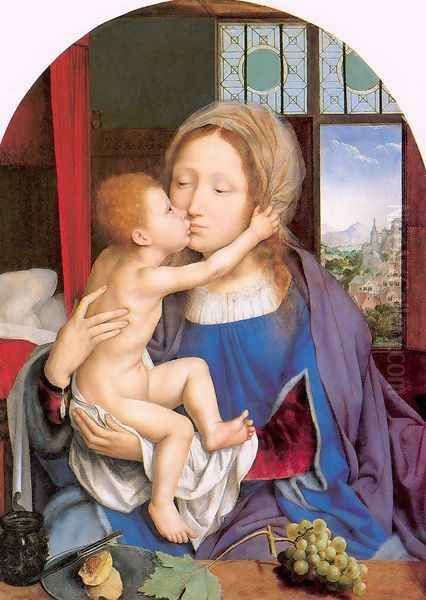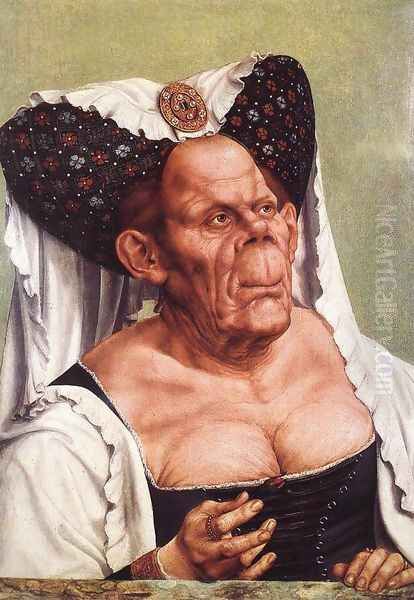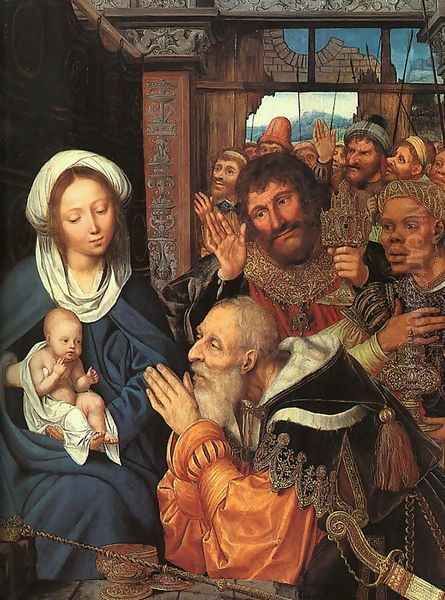Quentin Massys, also spelled Metsys or Matsys, stands as a colossus in the art history of the Low Countries, a foundational figure of the Antwerp School, and a crucial bridge between the late Gothic traditions of Flanders and the burgeoning influences of the Italian Renaissance. Active during a period of profound cultural, religious, and economic transformation, Massys's oeuvre reflects the complexities of his time, showcasing a remarkable versatility that spanned devotional religious paintings, incisive portraits, and pioneering genre scenes laden with moral and satirical commentary. His work not only captured the zeitgeist of early 16th-century Antwerp but also left an indelible mark on subsequent generations of artists across Northern Europe.
Early Life and Artistic Genesis in Leuven
Born in Leuven around 1465 or 1466, a prominent university town in the Duchy of Brabant (now Belgium), Quentin Massys's early life is shrouded in a degree of romantic legend. The traditional narrative, popularized by early biographers like Karel van Mander, suggests he was initially trained as a blacksmith, following in his father Joost Massys's footsteps. According to this tale, he was compelled to switch trades either due to illness or, more romantically, to win the hand of an artist's daughter who would only marry a painter. While the veracity of this specific anecdote is debated by modern scholars, it is plausible that he had some familiarity with metalwork, which might have informed his later precision and even his creation of portrait medals.
Regardless of the exact circumstances, it is clear that Massys received artistic training, though the identity of his master remains unknown. Leuven, at the time, had a respectable artistic tradition, influenced by masters like Dieric Bouts. It is likely that Massys absorbed the prevailing late Gothic style, characterized by meticulous detail, rich symbolism, and a somewhat stiff, though often emotionally resonant, depiction of figures. This early grounding in the Flemish Primitives' techniques would form a lasting foundation for his later innovations.
Antwerp: The Crucible of a New Artistic Vision

Around 1491, Quentin Massys relocated to Antwerp. This move was a pivotal moment in his career. Antwerp was rapidly ascending as the economic and cultural powerhouse of Northern Europe, eclipsing Bruges. Its bustling port, international merchant community, and burgeoning wealth created a fertile environment for artistic patronage and innovation. Massys was admitted as a master into the Guild of Saint Luke, the city's painters' guild, in that same year. His arrival and subsequent prominence are often cited as marking the beginning of the Antwerp School's golden age.
In Antwerp, Massys was exposed to a wider array of artistic currents. The city was a crossroads of trade and ideas, and Italian Renaissance concepts were beginning to permeate the North through prints, imported artworks, and traveling artists. Massys proved exceptionally adept at synthesizing these new influences with his native Flemish tradition. He did not merely imitate Italian models but selectively integrated elements like sfumato (the soft blurring of outlines, famously used by Leonardo da Vinci), more naturalistic figure depiction, and a greater emphasis on human emotion and psychological depth.
Religious Paintings: Tradition and Innovation
A significant portion of Quentin Massys's output consisted of religious works, a staple of artistic production in the era. His altarpieces and devotional panels demonstrate a profound understanding of traditional iconography while simultaneously infusing it with a new humanism and emotional sensitivity.
One of his earliest major commissions in this vein was the "Altarpiece of the Holy Kinship" or "Saint Anne Altarpiece" (c. 1507-1509), created for the Confraternity of St. Anne in the St. Peter's Church in Leuven, though painted in Antwerp. This triptych, now in the Royal Museums of Fine Arts of Belgium, Brussels, depicts the Virgin and Child with Saint Anne and other members of the Holy Family in the central panel. The side panels show scenes from the lives of Saint Joachim and Saint Anne. The work is notable for its harmonious composition, tender interactions between figures, and the gentle, almost sweet, expressions, particularly on the faces of the women and children. The architectural settings and landscape backgrounds show a developing interest in perspective and atmospheric effects.

Another monumental religious work is "The Lamentation of Christ" or "The Entombment Altarpiece" (1508-1511), commissioned for the carpenters' guild chapel in Antwerp Cathedral and now housed in the Royal Museum of Fine Arts Antwerp. This triptych is a powerful and dramatic portrayal of grief. The central panel shows the dead Christ surrounded by mourning figures, including the Virgin Mary, Mary Magdalene, and Saint John the Evangelist. Massys masterfully conveys a spectrum of sorrow, from the Virgin's stoic anguish to Mary Magdalene's more overt despair. The figures are rendered with a sculptural solidity, and the composition is both complex and emotionally charged. The influence of earlier masters like Rogier van der Weyden is evident in the emotional intensity, but Massys brings a new level of naturalism and psychological nuance.
His depictions of the "Virgin and Child" were numerous and popular. These often show a tender, intimate relationship between mother and child, frequently set against detailed landscapes or domestic interiors. Works like the "Virgin and Child" in Brussels or the version in the National Gallery, London, showcase his delicate brushwork, soft modeling of flesh tones, and the subtle influence of Leonardo da Vinci in the gentle expressions and pyramidal compositions.
Portraiture: Capturing the Essence of the Sitter
Quentin Massys was also a highly accomplished portraitist, sought after by the intellectual and mercantile elite of Antwerp. His portraits are characterized by their sharp observation, psychological penetration, and meticulous rendering of textures and details.
Perhaps his most famous portrait is that of the Dutch humanist Desiderius Erasmus (1517), now in the Galleria Nazionale d'Arte Antica in Rome (Palazzo Barberini). This work was part of a diptych, with the other panel depicting Erasmus's friend, Peter Gilles (Pieter Gillis), the town clerk of Antwerp. The portrait of Erasmus shows him at his writing desk, engaged in scholarly pursuits, a common trope for humanist portraits. Massys captures not only Erasmus's physical likeness but also his intellectual intensity and thoughtful demeanor. The careful depiction of books, writing implements, and the texture of his fur-lined robe speaks to Massys's skill in rendering material reality. This portrait, and its companion, were gifts for Sir Thomas More in England, highlighting the international network of humanist scholars and patrons.
Massys's approach to portraiture often went beyond mere likeness, aiming to convey the sitter's character and social standing. He employed a clarity and precision inherited from the Flemish tradition of artists like Jan van Eyck and Hans Memling, but imbued his subjects with a greater sense of presence and interiority, reflecting the growing Renaissance interest in the individual.
Genre Scenes and Satire: Moralizing the Mundane
Quentin Massys is particularly celebrated for his pioneering work in genre painting, often imbued with satirical or moralizing undertones. These scenes, depicting everyday life or allegorical figures, provided a vehicle for social commentary.

The most iconic example is "The Money Changer and His Wife" (1514), housed in the Musée du Louvre, Paris. This painting depicts a couple in their counting house. The husband meticulously weighs coins, a symbol of commerce and perhaps avarice, while his wife, momentarily distracted from her prayer book, gazes at the gold. The scene is rich in symbolism: the snuffed-out candle can represent the transience of life or the presence of the divine, the apple on the shelf alludes to original sin, and the convex mirror reflects a figure in a window, possibly the artist himself, a device famously used by Jan van Eyck in the "Arnolfini Portrait." The painting is often interpreted as a critique of greed and worldly attachment, contrasting financial concerns with spiritual devotion. It reflects the anxieties of a society grappling with new forms of wealth and the moral implications of a burgeoning capitalist economy. This theme was later taken up by artists like Marinus van Reymerswaele.
Another striking and somewhat enigmatic work is "The Ugly Duchess" (c. 1513), also known as "A Grotesque Old Woman," in the National Gallery, London. This unflinching portrait depicts an elderly woman with exaggerated, almost caricatured features, adorned in aristocratic, albeit outdated, attire. She holds a red flower, a symbol of engagement, suggesting she is seeking a suitor despite her advanced age and unconventional appearance. The painting is a powerful example of the grotesque in art and has been linked to Leonardo da Vinci's studies of grotesque heads. Whether it is a satirical commentary on vanity, a depiction of a specific individual suffering from Paget's disease (as some have hypothesized), or a more generalized allegory, it remains a fascinating and unsettling image. It is famously said to have inspired Sir John Tenniel's illustrations of the Duchess in Lewis Carroll's "Alice's Adventures in Wonderland."
These genre scenes demonstrate Massys's keen observation of human nature and societal mores. He skillfully blended realism with symbolism, creating works that were both engaging and thought-provoking, laying the groundwork for later Netherlandish genre painters like Pieter Bruegel the Elder and Pieter Aertsen.
The Massys Workshop and Artistic Collaborations
Like many successful artists of his time, Quentin Massys maintained an active workshop in Antwerp. This studio would have employed assistants and apprentices who helped with the production of paintings, including making copies of popular compositions and assisting with larger commissions. His sons, Jan Massys (c. 1509-1575) and Cornelis Massys (c. 1510-1557), both became painters and likely received their initial training in their father's workshop. Jan Massys, in particular, continued his father's style, though he later developed his own distinct manner, often focusing on eroticized mythological and allegorical scenes after spending time in Italy and France. Cornelis became known more for his landscape paintings and engravings.
Quentin Massys also engaged in collaborations with other artists. Most notably, he is known to have worked with Joachim Patinir (c. 1480-1524), a pioneer of landscape painting. In such collaborations, Patinir would typically paint the expansive, atmospheric landscapes, while Massys would be responsible for the figures. "The Temptation of Saint Anthony" (Prado, Madrid) is often cited as an example of their joint work, though attributions can be complex. This practice of specialization and collaboration was common in the Antwerp art market.
Encounters with Contemporaries: Dürer and Others
Antwerp's cosmopolitan environment facilitated interactions between artists from different regions. The celebrated German master Albrecht Dürer visited Antwerp in 1520-1521 during his journey to the Netherlands. Dürer's diary records a visit to Massys's house in August 1520. While Dürer mentions the visit, he provides little detail about their conversation or any profound artistic exchange, simply noting that he saw Massys's house. However, Dürer did attend a banquet hosted by the Antwerp painters' guild, where Massys would likely have been present. Dürer also famously drew a portrait of Erasmus during this trip, a subject Massys had painted a few years prior.
The artistic relationship between Massys and Jan Gossaert (also known as Mabuse) is another area of interest. Gossaert was one of the first Netherlandish artists to travel to Italy and fully embrace Italian Renaissance forms, particularly in his depiction of the nude and classical architecture. While their styles differed, both Massys and Gossaert were key figures in introducing Renaissance elements into Northern art, and there may have been mutual awareness and influence, particularly in their approach to portraiture and the modeling of figures.
Massys's art also shows an awareness of other Northern contemporaries like Lucas van Leyden, whose prints circulated widely, and perhaps even the work of Hans Holbein the Younger, though Holbein's major impact came slightly later. The influence of earlier Flemish masters like Jan van Eyck, Rogier van der Weyden, and Hugo van der Goes is undeniable in Massys's technique and emotional depth, forming the bedrock upon which he built his innovations. He also seems to have been aware of the work of Italian artists beyond Leonardo, possibly through prints by artists like Andrea Mantegna or Marcantonio Raimondi.
Artistic Style: A Synthesis of North and South
Quentin Massys's artistic style is a complex and masterful fusion. From his Flemish heritage, he retained the meticulous attention to detail, the rich oil glazes that created luminous color, and a profound interest in capturing the textures of fabrics, metals, and flesh. His compositions often feature intricate symbolism, characteristic of Northern European art.
From the Italian Renaissance, he adopted a greater sense of volume and plasticity in his figures, a more naturalistic approach to anatomy and movement, and the use of sfumato to create softer transitions and a more atmospheric quality. His interest in classical proportion and harmonious composition also reflects Italianate ideals. However, Massys never fully abandoned his Northern roots; his figures often retain a certain Gothic angularity, and his emotional expression can be more intense and direct than that typically found in Italian High Renaissance art. He was a selective borrower, adapting Italian ideas to suit his own artistic temperament and the tastes of his Northern patrons. This ability to synthesize diverse influences into a coherent and personal style is a hallmark of his genius.
Later Life, Death, and Enduring Legacy
Quentin Massys remained a leading figure in Antwerp's art scene until his death in the city in 1530. An epitaph in Antwerp Cathedral, though possibly inscribed later, gives his death year as 1529, but most scholarly consensus points to 1530. He was a respected and prosperous citizen, and his influence extended through his sons and the many artists who passed through Antwerp.
His impact on the development of Northern European art was profound. In religious painting, he revitalized traditional themes with new emotional depth and technical refinement. In portraiture, he captured the burgeoning humanist spirit and the character of a new mercantile class. Most significantly, his satirical and moralizing genre scenes were groundbreaking, paving the way for the rich tradition of Netherlandish genre painting that would flourish in the later 16th and 17th centuries with artists such as Pieter Bruegel the Elder, Adriaen Brouwer, and David Teniers the Younger.
While some controversies exist, such as the precise nature of his relationship with Leonardo da Vinci's work (whether through direct observation, copies, or prints), and the exact attributions of some workshop pieces, his stature is undiminished. He is recognized as the first great painter of the Antwerp School, a master technician, a keen observer of humanity, and an artist who successfully navigated the transition from the late medieval world to the early modern era. His works continue to fascinate viewers with their technical brilliance, psychological insight, and enduring commentary on the human condition. Artists like Joos van Cleve and Bernard van Orley, active in Antwerp and Brussels respectively, also show the pervasive influence of the new stylistic trends that Massys helped to popularize.
Conclusion: The Enduring Significance of Quentin Massys
Quentin Massys was more than just a skilled painter; he was an innovator who played a crucial role in shaping the course of Northern Renaissance art. His ability to absorb and transform diverse artistic influences—the meticulous realism of his Flemish predecessors, the humanistic ideals and technical innovations of the Italian Renaissance—resulted in a body of work that is both deeply rooted in its time and remarkably timeless in its appeal. From the tender devotion of his Madonnas and the dramatic intensity of his altarpieces to the incisive character studies of his portraits and the witty, often biting, social commentary of his genre scenes, Massys demonstrated an extraordinary range and depth. He effectively established Antwerp as a leading artistic center, and his legacy resonated through the work of his sons, his workshop, and countless artists who followed, ensuring his place as one of the most important painters of his era.